This Dr. Axe content is medically reviewed or fact checked to ensure factually accurate information.
With strict editorial sourcing guidelines, we only link to academic research institutions, reputable media sites and, when research is available, medically peer-reviewed studies. Note that the numbers in parentheses (1, 2, etc.) are clickable links to these studies.
The information in our articles is NOT intended to replace a one-on-one relationship with a qualified health care professional and is not intended as medical advice.
This article is based on scientific evidence, written by experts and fact checked by our trained editorial staff. Note that the numbers in parentheses (1, 2, etc.) are clickable links to medically peer-reviewed studies.
Our team includes licensed nutritionists and dietitians, certified health education specialists, as well as certified strength and conditioning specialists, personal trainers and corrective exercise specialists. Our team aims to be not only thorough with its research, but also objective and unbiased.
The information in our articles is NOT intended to replace a one-on-one relationship with a qualified health care professional and is not intended as medical advice.
What Is a Chiropractor? Surprising Facts About Chiropractic Care
October 8, 2018

Today there are more than 77,000 licensed Doctors of Chiropractic (DC) in the U.S. alone, plus thousands more practicing in countries throughout the world. (1) As one of the most popular types of alternative treatment approaches (meaning those that are non-medical), millions of people each year seek chiropractic care.
Since its official beginning more than 100 years ago, chiropractic education and care has since come a very long way. While in the past certain medical doctors may not have spoken positively about the field of chiropractic, speculating that chiropractic adjustments weren’t necessarily as effective as treatments like drugs or surgery, today things are different. Many MD’s regularly refer their patients to Chiropractors for help with a range of symptoms, everything from migraines and joint pain, to constipation and visual problems.
Chiropractic care is considered an alternative treatment approach to taking pain-killing drugs or undergoing surgery. Many people don’t realize that similarly to medical doctors, Chiropractors spend years in training — thoroughly learning about subjects like anatomy, physiology, nutrition and holistic health.
When it comes to treating all-too-common complaints such as low back pain, organ dysfunction or other chronic disease symptoms, what is a Chiropractor capable of doing to help? Evidence shows that the influence of a chiropractic adjustment goes well beyond bad backs. Many unwanted symptoms suffered by children and adults today can be helped through the neurological influence of an adjustment.
Complementary to the adjustment, many Chiropractors today also offer their patients more than manual spinal adjustments: They are also well-versed in a variety of nutritional therapies, herbal supplementation, spinal physical therapy and stress management. They also work with other practitioners such as massage therapists or acupuncturists. Meanwhile, Chiropractors offer one of the best ways to prevent ailments, as opposed to only treating them.
What Is a Chiropractor?
Chiropractors are trained doctors who specialize in detecting and reducing misalignments of the spine called vertebral subluxation that interfere with central nervous system function. Subluxations can cause inflammation of the joint and nerve root as well as lack of motion which can cause joint degeneration.
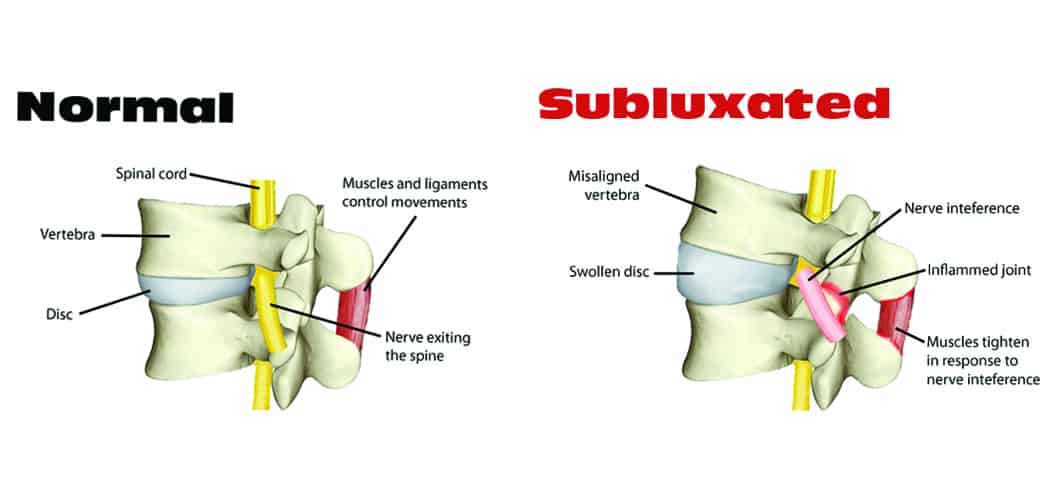
Chiropractors work in the field of complimentary or alternative medicine, treating patients by performing hands-on chiropractic adjustments in order to help with postural restoration, spinal alignment, nervous system function and maintenance of health. Chiropractic physicians are trained to use their hands as their “instrument,” carefully adjusting the joints of the body, especially the spine.
In fact, Chiropractic is one form of alternative medicine that are considered manual therapies. Rolfing, integrative manual therapy, massage therapy and myofascial release technique are also different manual therapies.
What are a Chiropractor’s specialties?
You might think of chiropractic adjustments as only being helpful for treating problems like systematic pain (such as back pain) or a stiff neck, but that’s far from true. In many ways, Chiropractors have a “stress-centered” view of health: the underlying belief of chiropractic care surrounds the fact that the body has an innate ability to heal itself once interferences or “obstacles” (sources of stress that stand in the way of well-being) are removed. (2)
Interferences that can negatively impact the nervous system and therefore diminish overall health, including the following: poor posture, poor nutrition, physical and emotional stress, muscular tension and tightness, and illness caused by a number of issues, including poor digestive health.
What is a Chiropractor hoping to do when they perform adjustments on patients?
Restoring motion and alignment of the spine is the first step in helping the rest of the body to self-regulate, self-maintain and self-restore, due to the spine’s direct neurological influence on the rest of the body. The American Chiropractic Association (ACA) states that ” The benefits of chiropractic care extend to general health issues, since our body structure affects our overall function.” (3)
- To simplify a complex process, they are tapping into the recuperative abilities of the body by restoring the relationship between a properly aligned spinal column and a well-functioning nervous system.
- Chiropractors are trained to carefully analyze the spine to determine the presence of vertebral subluxation, which is when a spinal bone misaligns, causing interference to the nervous system and nerve irritation. In other words, chiropractic care is beneficial because it allows for better communication throughout the body, especially between the spine and the brain, also called the Central Nervous System (CNS).
- The CNS is the controller of someone’s overall health, considering it regulates communication and coordination throughout the body that affects every organ, tissue and cell. You can think of the brain as the main commander (or control center) of the CNS and the whole body. The nervous system sends chemical messages to and from the brain via the spinal cord, which is not the actual backbone (vertebra), but the cord that runs within the bones in the back and contains threadlike nerves that branch out elsewhere.
Top 7 Benefits of Chiropractic
Does Chiropractic work? And for what ailments?
According to Dr. Dan Sullivan — Doctor of Chiropractic (DC), speaker, author and one of the most well respected holistic health experts in the country —
One of the biggest challenges that Chiropractors face is the public’s perception of Chiropractic. Many still believe that the benefits of chiropractic adjustments are limited to back and neck pain relief. But that is just a small portion of the benefits that chiropractic care delivers. Some of the greatest evidence today shows exactly why Chiropractors have been seeing amazing results in their offices, each week, for over 120 years, with symptoms and conditions seemingly unrelated to the spine.
It all comes back to how Chiropractic positively influences the nervous system. From improved breathing and digestion, to increased immunity, better organ function, fertility and so much more, we now know from a scientific and research standpoint how adjustments can have such far-reaching benefits.
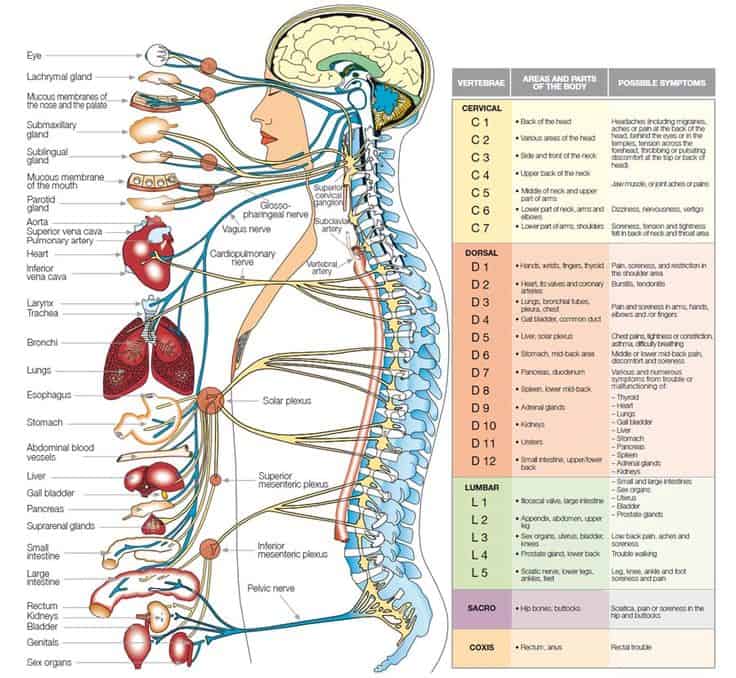
Patients who can benefit from visiting a Chiropractor include those with symptoms or diseases such as:
- Back pain (4)
- Neck pain (5)
- Migraines or frequent headaches (6)
- Asthma (7)
- Sciatica (8)
- Back pain due to pregnancy (9)
-
Acid Reflux (10)
-
Colic (11)
-
Heart problems including high blood pressure (13)
-
Frozen shoulder (glenohumeral or acromioclavicular (AC) joint) (15)
-
Joint pains and osteoarthritis (16)
- Neurological problems such as epilepsy (17)
- Brain/Central Nervous System dysfunction
-
Insomnia/trouble sleeping (18)
- TMJ
- Injuries and disorders of the musculoskeletal system, involving the muscles, ligaments and joints
- Indigestion or upset stomach
- Dental or visual problems
- Injuries due to accidents or trauma
One of the reasons why Chiropractic is tied to so many benefits is because it has been shown to help reduce inflammation, the root cause of many different diseases. (19) Another factor behind why Chiropractic can help numerous health challenges has to do with it balancing out the bodies sympathetic/parasympathetic response of the nervous system. Most people live in a sympathetic “fight or flight” response and a chiropractic adjustment in the upper cervical region and sacral region can stimulate a parasympathetic response that reduces stress and allows certain organs to function to a higher degree including the digestive and endocrine systems.
A study published in the Journal of Chiropractic Medicine done on 40 participants found after receiving a cervical adjustment, pulse rates decreased, blood pressure balanced and there was a significantly positive parasympathetic response. (20)
This systematic review shows why so many people choose to visit a Chiropractor on a regular basis even if they don’t have symptoms because they understand the benefits of decreasing ongoing stress and maintaining a healthy spine and nervous system.
Because chiropractic adjustments can help decrease the stress load on the nervous system, chiropractic care sets the stage for recovery and healing. Contrary to that of most medical doctors or other healthcare providers, Chiropractors do not seek to cure or remove the symptom, ailment or condition. It is important to note that Chiropractors focus on removing interference from the nervous system so that patients can heal and function the way they were intended. (21)
Chiropractors take pride in educating their patients about how the human body is designed to heal, and that the body is programmed to be constantly striving towards health. Anyone with altered spinal alignment or movement can be helped by a Chiropractor. However, because the central nervous system directs all healing in the body, many symptoms and conditions have been proven to be helped through the influence of a chiropractic adjustment.
Below are some of the greatest benefits associated with chiropractic care:
1. Back Pain
Spinal adjustments and certain other chiropractic techniques have been shown in many studies to help treat neuro-musculoskeletal conditions, including low back pain. Back pain — particularly in the lumbar spine region or lower back — is one of the most common reasons that adults visit Chiropractors every year. Chiropractic for treatment of back pain and the lumbar spine has been so well-supported in studies that it’s no longer even considered “alternative care.”
According to the National Institute of Health,
Spinal manipulation is one of several options — including exercise, massage and physical therapy — that can provide mild-to-moderate relief from low-back pain. Spinal manipulation appears to work as well as conventional treatments such as applying heat, using a firm mattress and taking pain-relieving medications.
2. Neck Pain
Neck pain is another common problem that can be caused by factors such as injuries, trauma, stress, poor sleep, arthritis, older age and degenerative disc disease. Chiropractors employ neck manipulation and use techniques including adjustments, mobilization, massage or rehabilitative exercises to help relieve pressure placed on the neck.
A 2007 study published in the Journal of Manipulative and Physiological Therapeutics found strong evidence that patients with chronic neck pain showed significant pain-level improvements following spinal adjustments that lasted for at least 12 weeks post-treatment. One chiropractor technique that is used for neck pain is called craniosacral therapy.
3. Migraines and Headaches
Adjustments to the spine, neck and head can be very effective for treating recurring headaches, including tension headaches and migraine headaches. Adjustments and neck manipulation can help restore posture of the head and relieve pressure and tension on nerves that contribute to headaches. A group trial found that 22 percent of people who had chiropractic treatment saw the number of attacks drop by 90 percent. In this systematic review, 49 percent said they had a significant reduction in pain intensity. (22) Compared to most medical treatments, few interventions can initiate headache relief naturally, without the risks of taking drugs long-term, like chiropractic adjustments can.
4. TMJ
There’s evidence showing that symptoms due to temporomandibular joint (TMJ) pain, such as pain while sleeping or trouble opening up the mouth and chewing properly, can be managed with adjustments and neck manipulation that helps correct posture of the neck and jaw. One method that has been shown to be useful for TMJ is called the Activator Method, which involves making precise adjustments to the jaw with a small hand-held instrument. (23)
5. Injuries of the Musculoskeletal System
Many symptoms due to injuries affecting involving the muscles, ligaments and joints can be treated with chiropractic care. Chiropractors use a variety of precise techniques like adjustments, massage therapy, stretching, exercises and weights to help relax tense muscles and improve posture. This helps to treat symptoms including muscle pain, tightness, reduced range of motion, weakness due to muscular compensations and spasms. Certain muscles that are overactive can be “turned off” while others that are under-used can be “turned on.”
6. Digestive Problems
Digestive issues can be tied to both stress and spinal misalignments, due to how both negatively affect the nervous system’s communication with the organs, glands and tissues of the digestive system. Following chiropractic treatments, the gut-brain connection can be restored in order to improve control and function of nerves and muscles in the GI tract. Chiropractic techniques aimed at evoking relaxation, improving blood flow to the digestive organs, and improving communication between the nervous system and gut are all used to treat a range of digestive problems — such as IBS, constipation, diarrhea, acid reflux, etc.
7. Joint Pain
According to the Arthritis Foundation, chiropractic is considered one of the safest therapies someone can use to treat joint pain. Chiropractors can help to relieve joint pain, such as those caused by osteoarthritis, by gently manipulating soft tissue and helping to improve overall functionality and posture. DCs may use active exercises and slow stretches to increase range of motion in stiff joints, as well as to relieve pressure placed on certain nerves or to stop muscle spasms that contribute to pain.
History
The natural healing abilities attributed to chiropractic care was first developed by a man named D.D. Palmer in 1895. According to records regarding the first chiropractic treatments, it all started when Harvey Lillard — a man who was deaf in one ear — had seen Palmer for help with his condition.
Mr. Lillard was hoping that D.D. Palmer had something up his sleeve to help his deafness. When Palmer learned that Lillard suffered a head injury that preceded his hearing condition, he evaluated his spine and noticed that a vertebra in the upper back seemed wildly out of alignment. (24) According to Palmer:
I had a case of heart trouble which was not improving. I examined the spine and found a displaced vertebra pressing against the nerves, which innervate the heart. I adjusted the vertebra and gave immediate relief — nothing ‘accidental’ or ‘crude’ about this. Then I began to reason if two diseases, so dissimilar as deafness and heart trouble, came from impingement, a pressure on nerves, were not other disease due to a similar cause? Thus the science (knowledge) and art (adjusting) of Chiropractic were formed at that time.
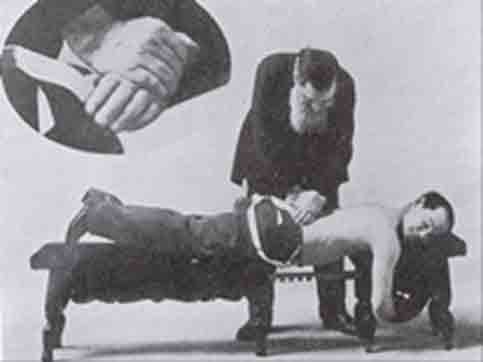
Palmer coined his manual therapy technique “chiropractic,” which comes from the two Greek words cheiros and praktikos (meaning “with hands”). While D.D Palmer is considered to be the first Chiropractor, records show that similar adjustments have been utilized to help the body heal itself dating back to the time of Hippocrates. Since the time of Palmer, millions of people across the globe have benefited from this manual therapy. In 1897, Palmer helped establish the very first chiropractic school, located in the U.S. and now called the Palmer College of Chiropractic (formerly the Palmer Chiropractic School and Cure).
Education and Licensure
According to the International Chiropractors Association, “Chiropractic is the fastest growing and second-largest primary healthcare profession.” There are approximately 95,000 doctors of chiropractic (DCs) practicing around the world, and more than 10,000 students currently enrolled in chiropractic education in the U.S. alone.
Once their training is completed, many Chiropractors feel that they specialize in a combination of science, art and philosophy, practicing a holistic system of health that takes into account the many different aspects of their patients’ lives. Once graduated from a school of chiropractic, doctors of chiropractic can work in private practice or in clinical settings, specializing in areas including work-place safety, stress management, injury prevention, postural correction and nutritional counseling.
The formal education required to become a Chiropractor focuses on teaching practitioners to effectively locate patients’ vertebral subluxations and remove them through the use of specific adjustment techniques. Chiropractic education also emphasizes the practice’s underlying philosophy, that the body wants to and is capable of healing itself.
How many years of schooling does a chiropractor receive?
According to the American Chiropractic Association, “Educational and licensing requirements for doctors of chiropractic (DCs) are among the most stringent of any of the health care professions.” DCs must complete four years of doctoral graduate school in order to qualify for exams that must be passed before becoming licensed. Prior to beginning graduate studies in chiropractic training, four years of pre-medical undergraduate college education must be completed. Undergraduate courses must include biology, inorganic and organic chemistry, physics, psychology and related lab work.
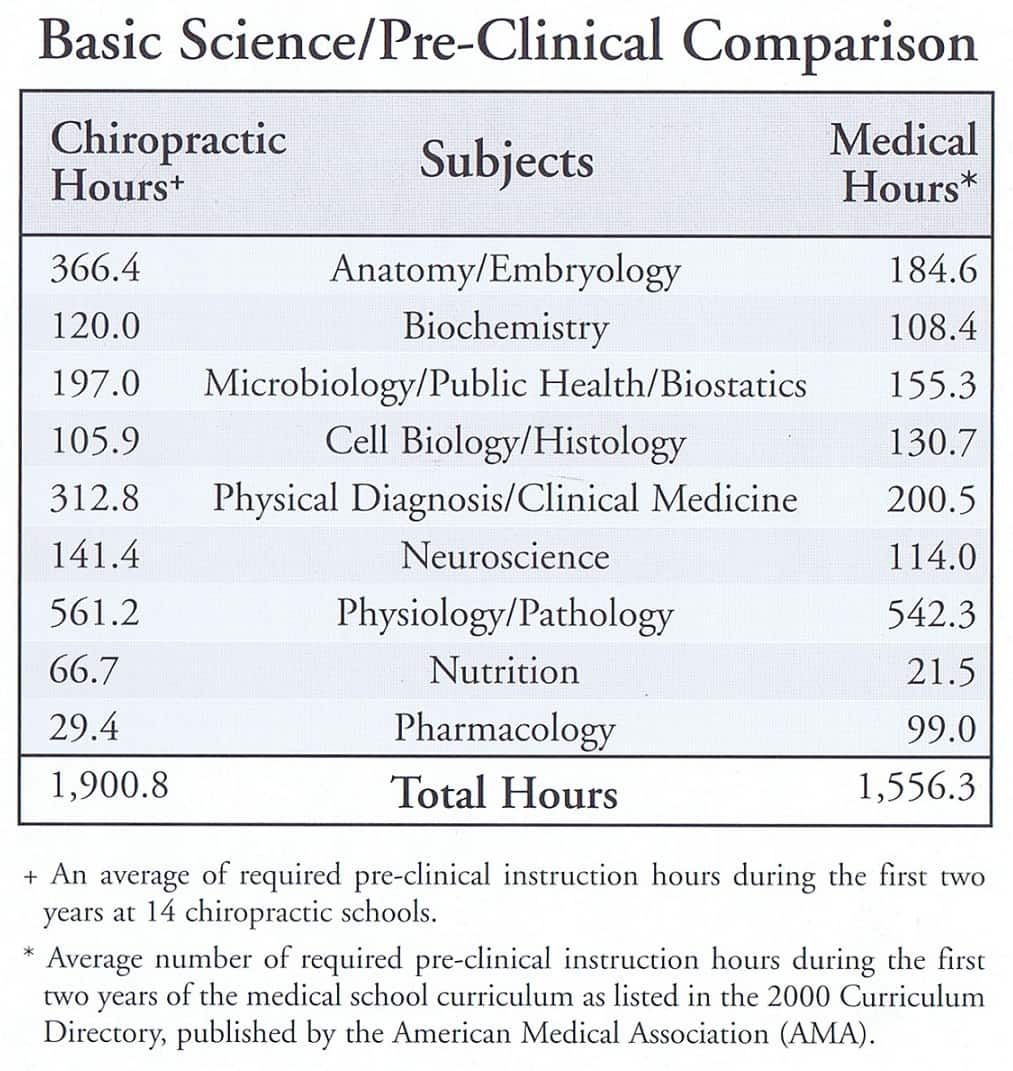
How to become a chiropractor
After approximately 4,620 hours of graduate classroom education, laboratory work and clinical internship, prospective DCs qualify to take exams administered by state licensing boards. As part of their training, DCs must complete a minimum of a one-year clinical-based program dealing with patients in a treatment setting. Exact requirements in order to practice vary by state, but usually DC licensure requires successful completion of a medical licensing or acceptance of a certificate issued by the National Board of Chiropractic Examiners (NBCE). Once a DC obtains a license in the state in which they wish to practice, they can began seeing patients in a variety of settings.
DCs must continue their education each year, completing ongoing training in order to stay up to date on the latest chiropractic treatment approaches and to maintain their licensure. Many also go on to complete training programs in other complementary approaches, such as Active Release Technique, Functional Medicine, Chiropractic Neurology, Pediatrics, Sports Chiropractic and Neurokinetic Therapy (NKT), a type of natural therapeutic system that has the goal of correcting learned movements and muscle functions within the body.
For help finding a qualified and licensed DC in your area, you can search by location on the International Chiropractic Association website. Additionally, you can ask your primary doctor for a recommendation or seek out referrals from friends, family members, colleagues, etc.
What are some chiropractic colleges/schools?
There are now more than 40 chiropractic schools located throughout the world, including 20 within the U.S. In the U.S, the Council on Chiropractic Education (CCE) and its Commission on Accreditation is the national organization that is considered to be the authority when it comes to regulating the quality of training offered by different chiropractic colleges.
The CEE was established in the 1930s and is now recognized by the Secretary of the United States Department of Education and is a member of the Council on Higher Education Accreditation (C.H.E.A.) and the Association of Specialized and Professional Accreditors (A.S.P.A.). In the 1990s, the Association of Chiropractic Colleges was established to provide support for chiropractic schools and research, in addition to helping promote chiropractic care to patients and doctors. If you’re interested in a future career as a Chiropractor, visit the CCE’s website to review information about prerequisites, lists of accredited courses and college reviews.
In the U.S., below is a list of some of the chiropractic schools/colleges that meet qualifications for the CCE include:
- Cleveland Chiropractic College
- Life Chiropractic College East
- Life Chiropractic College West
- Logan University
- National University of Health Sciences of St. Petersburg
- National University of Health Sciences of Chicago
- New York Chiropractic College
- Palmer Chiropractic College California
- Palmer Chiropractic College Iowa
- Palmer Chiropractic College Florida
- Parker University
- Sherman College of Chiropractic
- Southern California University of Health Sciences
- Texas Chiropractic College
- University of Western States
What is a typical chiropractor’s salary?
When looking at Chiropractor occupations, the median income of practicing DCs is $142,729. (25) Salaries typically range between $121,288–$196,758. Salaries range considerably depending on the Chiropractor’s level of experience, exact location and specific offerings. For example, also offering nutritional support or other treatments to patients can increase a Chiropractor’s salary.
Most practicing DCs are self-employed and about 65 percent are male. Those who own their own clinics have larger incomes than those who work as associates or employees. As a comparison, physicians (MDs) earn an average salary of $195,161, dentists an average of $158,000 and podiatrists $119,000.
Straight vs. Mixer Chiropractors
While training for all Chiropractors is rooted in the same underlying philosophy and principles, today Chiropractors vary widely in terms of how they are specifically educated and how they choose to actually practice once licensed.
- Some practicing Chiropractors have a more conservative/traditional approach, sticking closely to the foundations of chiropractic care based on vertebral subluxation techniques that have been practiced for decades. Others are more “modern,” blending different treatment approaches in order to offer their patients a wider range of alternative therapies.
- Even various chiropractic colleges and institutions differ in terms of how traditional versus modern/liberal (or “straight vs. mixed) they are, which influences the types of doctors that graduate from different colleges.
To describe how different Chiropractors fall somewhere along a spectrum and to distinguish between different types (traditional vs. more modern), the labels “straight” and “mixer” are often used to:
- Straight Chiropractors range in terms of their exact beliefs and patient offerings, but generally speaking they stick to spinal adjustments as their core offering and typically stay away from using rehabilitation, nutrition and other therapies in their clinics.
- Mixer Chiropractors are more likely to work with other healthcare providers, to practice multidisciplinary care, give dietary advice, prescribe supplements, teach spinal rehabilitative exercises and do other treatment techniques including acupuncture and massage.
Chiropractic Organizations
Large chiropractic organizations, including the International Chiropractic Association (ICA) and the American Chiropractic Association (ACA), take different stances on certain issues in chiropractic care. There are certain conflicts between the two associations, as they have different perspectives regarding how Chiropractors should practice, and generally speaking all Chiropractors will usually take one side or the other.
As Dr. Dan Sullivan explains,
There has always been a divide in the profession between the more traditional-practicing ‘straight’ Chiropractors and the more broad-scoped ‘mixer’ Chiropractors. Both types of Chiropractors help their patients overcome health challenges and uniquely improve function for all ages through the location and correction of vertebral subluxation. And the continued advancement of the profession Chiropractic centers around the fact that the body is self-healing and that chiropractic adjustments remove interference to allow better function and health for children and adults of all ages. Both types of Chiropractors agree on this central focus. And the best part is that the scientific evidence now explains and supports the overall practice of Chiropractic like never before.
- The ICA states that they are “committed to the rights of the chiropractic practitioner and his/her patients as it was nine decades ago. ICA welcomes all Chiropractors who believe in and want: advancing chiropractic’s distinct identity as a drugless healing art, full integration of chiropractic with other health care professions —not subordination” and other benefits.
- The ACA states that they are “The largest national association in the U.S. dedicated to advancing the chiropractic profession.” The ACA emphasizes the need for evidence-based research to support the field of chiropractic. They support lobbies for pro-chiropractic legislation and policies, aim to promote a positive public image of chiropractic, provide ongoing professional and educational opportunities for doctors of chiropractic, and offer leadership for the advancement of the profession.
In addition, the American Chiropractic Association (ACA) covers Chiropractic-related news, including recent studies, events and education, among other subjects.
Chiropractors vs. Medical Doctors
Is a Chiropractor a doctor? Yes, as mentioned above, Chiropractors hold a degree as a Doctor of Chiropractic (DC). (26) They are not medical doctors (MDs) because they do not write their patients prescriptions or perform surgeries. Chiropractors uniquely help their patients heal through natural means by removing interferences from the central nervous system. The education that DCs receive focuses on all basic sciences, anatomy and physiology, with special emphasis on the health and function of the spine and central nervous system.
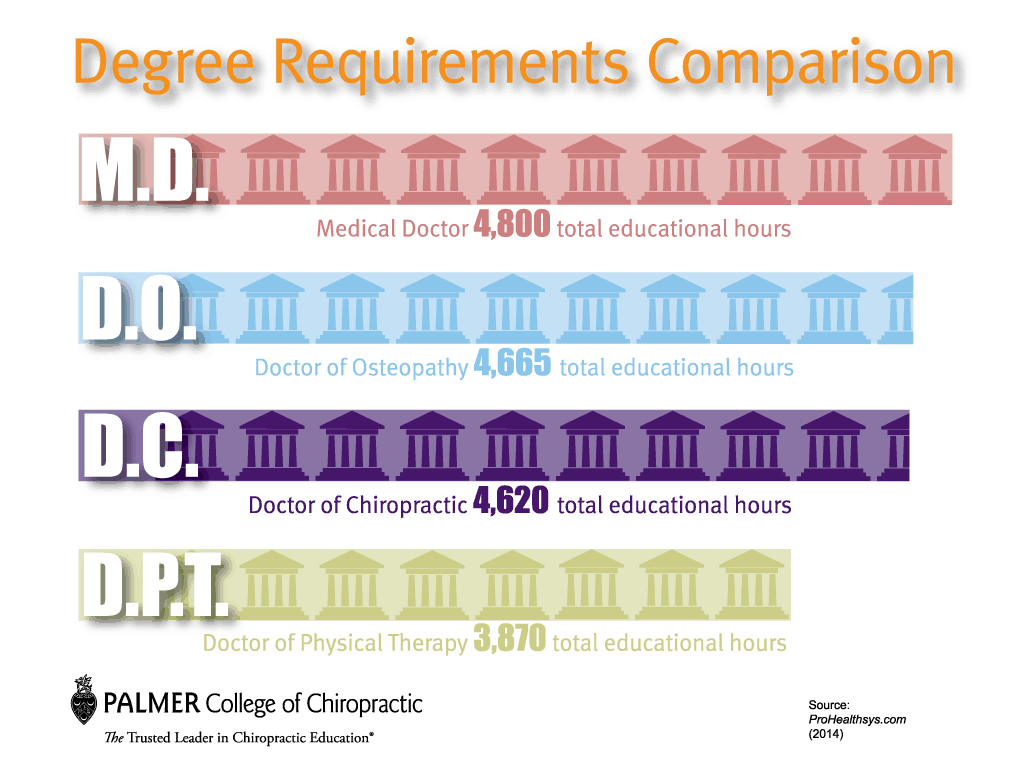
Two of the leading alternative health care systems practiced in the U.S. and elsewhere today are osteopathy (osteopathic manipulative therapy) and chiropractic care. These two approaches are closely related and require similar training, but osteopaths do more global manipulations of the spine where Chiropractors do more specific vertebral adjustments.
- Chiropractors are holistic, non-invasive practitioners who focus on disease prevention as well as symptom management. DCs specialize in vertebral subluxation, or removing interference of the nervous system due to a misalignment and/ or abnormal motion of spinal vertebra. When vertebral subluxation is left untreated, it leads to improper communication between nerves, organs, muscles and tissues. This contributes to widespread function control problems and can lead to symptoms in any or all parts of the body.
- Chiropractic is the art of restoring the body to its natural state utilizing many different techniques, which can include manual adjustments but also stress-reduction, inflammation-reduction and dietary improvement. Rather than using medications to achieve this, DCs focus on removing irritation interference in the central nervous system (subluxations) that causes the body to break down and dysfunction.
- DCs are somewhat different from primary care physicians, or MDs, because they emphasize “a whole-person approach” to treatment and care. And rather than focusing only on relieving symptoms once a patient has already started to feel unwell, Chiropractors try to find the root cause of their patients’ problems in order to fix the underlying issue.
- DCs commonly get to know their patients well, taking their time during visits to discuss the patient’s unique symptoms, medical history, lifestyle, level of stress, diet and sleep. It’s very important for Chiropractors to really understand their patients in a holistic sense, in order to not only develop a treatment plan, but a way to help prevent symptoms from returning in the future.
- Seeing a Chiropractor is not meant to replace visits with your regular doctor. In fact, most Chiropractors have a working relationship with local Medical Doctors, co-managing the care of a patient to provide the best possible outcomes. A written referral is not needed to see a doctor of chiropractic (DC) because they are primary care physicians. Just like seeing a MD, chiropractic care is included in most health insurance plans, including major many medical plans, workers’ compensation, Medicare, some Medicaid plans and Blue Cross Blue Shield plans.
Different Approaches
DCs use hundreds of different approaches in chiropractic practice, some (but not all) involving thrust techniques. The difference between most chiropractic techniques is the degree of force applied. Most adjustments are done quickly, involving high speed to help with realignment. Sometimes an instrument besides the hands is also used.
Spinal adjustments are among many chiropractic techniques, but not the only types that are offered. Below you’ll find a brief description of some of the most common chiropractic treatment techniques that evolved over the past several decades, which address abnormalities in the spine, neck, head, pelvis, joints and muscles. When you visit a chiropractor, you might be treated with any number or combination of techniques, depending on your specific anatomy and needs:
-
- Activator: A hand held instrument that applies an impulse and is used to help release joint and muscle tension. Done quickly with a gentle, low force, making it suitable for patients who are sensitive.
- Applied Kinesiology: Helps to assess the nervous system by utilizing changes in muscular strength as different sensory stimuli are applied to the body. This allows for the DC to determine which nerves are “speaking” most to muscles. Often used to help determine which treatments are needed.
- Atlas Orthogonal [AOT]: Aims to restore structural integrity from cervical vertebral malposition. Uses a percussion instrument to correct postural restoration without manipulation or surgery. Focuses attention on the the Atlas, the top vertebrae of the spine that supports the head. Involves very gentle touch, reducing cervical spine misalignment and its related symptomatology.
- Blair Technique: Adjusts the upper cervical area, focusing on correcting misalignments in the first bone of the spine (Atlas) where it connects to the head (Occiput).
- Chiropractic Biophysics [CBP]: Corrects improper curvatures of the spine using a combination of traditional chiropractic manipulation, rehabilitation exercises, spinal traction and stretches to remodel tissues of the spine.
- Cox Flexion Distraction: Utilizes an adjusting table that has movable parts, along with a rocking motion, in order to stretch and decompress tissue surrounding the spine (spinal decompression).
- Diversified: Involves manual thrusts focused on restoring normal biomechanical function, including those in the extremity joints.
- Gonstead: Specific method of analysis by the use of nervoscopes, full spine x-rays and precise adjusting techniques. Helps to correct torquing of the spine in order to take pressure off of certain intervertebral discs.
- Motion Palpation: A method that helps to locate joint dysfunction within the spinal column and extremities. Palpation is the most frequently used diagnostic tool in chiropractic, allowing the DC to feel for subluxations in the vertebrae. In motion palpation the patient’s joints are mobilized, bending and flexing, or moving in different planes of motion to test range of motion.
- Network Chiropractic: Also called Network Spinal Analysis (NSA), this method involves regarding the body as a whole, integrated system. Light touch is used over the spinal cord to help activate receptors and increase the ability of the nerves and the spinal cord to communicate clearly. This is associated with improvements in gut-brain connection, increased self-awareness and reduced tension.
- Pettibon: Uses specially designed head, shoulder and hip weights that patients wear for up to 20 minutes daily until the spine is corrected, along with specific exercises. Weights help alter the head, spine and pelvis’s alignment, correcting sensory input to the nervous system and forming new muscle patterns.
- Sacral Occipital Technique [SOT]: Focuses on the relationship of between the sacrum and occiput (back of the skull) and is a form of Cranial Sacral therapy. This technique pays close attention to the the cranial bones and sacrum working to normalize cerebral spinal fluid flow and improve organ function.
- CLEAR Scoliosis Correction: A technique that combines adjustments, spinal exercises and vibration treatments to reduce scoliotic curves of the spine. 5–10 percent of the population has scoliosis and this condition can cause pain, joint degeneration and organic malfunction if it is not managed correctly.
- Thompson: Involves the use of an adjusting table with a weighing mechanism, helping to add precise amount of tension and keep the patient in an exact up position before the thrust is given.
- Torque Release: Directs attention to the source of spinal tension by testing posture starting from the feet up. Helps to determine which treatments are needed to relieve tension in the spine and spinal cord, which causes abnormal muscular patterns. Uses relatively small force corrections to achieve alterations in the spine and correct structural distortions using mechanical devices including the“Integrator” and the “Activator.”
- Toggle Recoil: A technique in which the hands are placed lightly on the area of joint restriction and then a fast, light thrust is applied. The hands are quickly removed from the contact point.
- Upper Cervical Chiropractic: Focuses on the relationship between the upper cervical spine (neck) and its influence on the central nervous system. Uses x-rays of the head and neck to determine which types of precise, non-invasive, gentle touch will help return the bones of the neck to a normal position.
- Webster: Involves sacral analysis and diversified adjustments used to reduce the effects of sacral subluxation/SI joint dysfunction. Aims to improve neuro-biomechanical function in the pelvis in order to reduce tension and tightness throughout the torso. Often used throughout pregnancy in preparation for a safer, easier birth and recovery.
Safety of Chiropractic Care
Is visiting a Chiropractor safe? The short answer is yes, very safe. You might be thinking that chiropractic adjustments sound risky, considering how sensitive the spine and spinal cord are to overall health and function. But in fact, chiropractic has been shown to be one of the safest treatment approaches in healthcare today. Chiropractic adjustments are very precise and careful, which is why DCs need to receive extensive training to ensure safety.
According to The National Institute of Health, “A 2007 study of treatment outcomes for 19,722 chiropractic patients in the United Kingdom concluded that minor side effects (such as temporary soreness similar to that which can be experienced after a workout) after cervical spine manipulation were relatively common, but that the risk of a serious adverse event was ‘low to very low’ immediately or up to 7 days after treatment.” Another study found that “there was no evidence that visiting a Chiropractor put people at greater risk than visiting a primary care physician.” (27)
While chiropractic treatment is overall very safe, it’s still possible to experience some potential adverse effects. The risks are low, but may include some temporary soreness, stiffness or tenderness following adjustments. Mild side effects typically go away on their own within about 24 hours.
Also keep in mind that a major advantage of visiting of a Chiropractor for help with pain or other symptoms is that you won’t be treated with drugs, which often cause a number of side effects. You may also be able to avoid having unnecessary surgery, which isn’t always effective and can pose its own risks.
In recent years, there’s been some concern in the media over whether chiropractic care could increase the risk of more serious side effects, such as stroke, neurological problems, internal bleeding or vertebral artery dissection. A number of studies have found no evidence that there is any link between chiropractic adjustments and suffering from a stroke. (28, 29)
Final Thoughts
- What is a Chiropractor? A Chiropractor is a trained doctor who specializes in detecting and reducing vertebral subluxation, or misalignments of the spine that interfere with the ability of the body’s nervous system to send and receive messages to and from the body. They also practice other holistic treatment approaches, including nutritional guidance, stress relief and soft tissue mobilization.
- Doctors of Chiropractic (DCs) must complete formal training that is similar to medical school required for primary care doctors. The process of becoming a DC involves 4 years of undergraduate study and an additional 4–5 years of graduate school, including internship and passing exams.
- Chiropractic has been practiced since the late 1890s. It is considered one of the safest approaches to treating patients that is offered today and a good choice for people with conditions including: back or neck pain, digestive issues, headaches, injuries and neuromusculoskeletal complaints.


